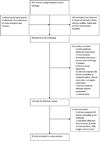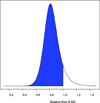Should perioperative supplemental oxygen be routinely recommended for surgery patients? A Bayesian meta-analysis
- PMID: 23160100
- PMCID: PMC3504355
- DOI: 10.1097/SLA.0b013e31826cc8da
Should perioperative supplemental oxygen be routinely recommended for surgery patients? A Bayesian meta-analysis
Abstract
Objective: The purpose of this study is to use updated data and Bayesian methods to evaluate the effectiveness of hyperoxia to reduce surgical site infections (SSIs) and/or mortality in both colorectal and all surgery patients. Because few trials assessed potential harms of hyperoxia, hazards were not included.
Background: Use of hyperoxia to reduce SSIs is controversial. Three recent meta-analyses have had conflicting conclusions.
Methods: A systematic literature search and review were performed. Traditional fixed-effect and random-effect meta-analyses and Bayesian meta-analysis were performed to evaluate SSIs and mortality.
Results: Traditional meta-analysis yielded a relative risk of an SSI with hyperoxia among all surgery patients of 0.84 [95% confidence interval (CI): 0.73-0.97] and 0.84 (95% CI: 0.61-1.16) for the fixed-effect and random-effect models, respectively. The probabilities of any risk reduction in SSIs among all surgery patients were 77%, 81%, and 83% for skeptical, neutral, and enthusiastic priors. The subset analysis of colorectal surgery patients increased the probabilities to 86%, 89%, and 92%. The probabilities of at least a 10% reduction were 57%, 62%, and 68% for all surgery patients and 71%, 75%, and 80% among the colorectal surgery subset.
Conclusions: There is a moderately high probability of a benefit to hyperoxia in reducing SSIs in colorectal surgery patients; however, the magnitude of benefit is relatively small and might not exceed treatment hazards. Further studies should focus on generalizability to other patient populations or on treatment hazards and other outcomes.
Figures






Similar articles
-
Revisiting the effectiveness of interventions to decrease surgical site infections in colorectal surgery: A Bayesian perspective.Surgery. 2012 Aug;152(2):202-11. doi: 10.1016/j.surg.2012.05.005. Surgery. 2012. PMID: 22828141
-
Supplemental perioperative oxygen for reducing surgical site infection: a meta-analysis.J Eval Clin Pract. 2009 Apr;15(2):360-5. doi: 10.1111/j.1365-2753.2008.01016.x. J Eval Clin Pract. 2009. PMID: 19335497 Review.
-
[A meta-analysis of perioperative hyperoxia for the surgical site infections in patients with general surgery].Zhonghua Yi Xue Za Zhi. 2016 May 31;96(20):1607-12. doi: 10.3760/cma.j.issn.0376-2491.2016.20.014. Zhonghua Yi Xue Za Zhi. 2016. PMID: 27266693 Chinese.
-
Perioperative supplemental oxygen therapy and surgical site infection: a meta-analysis of randomized controlled trials.Arch Surg. 2009 Apr;144(4):359-66; discussion 366-7. doi: 10.1001/archsurg.2009.1. Arch Surg. 2009. PMID: 19380650 Review.
-
Supplemental Oxygen and Surgical Site Infection in Colorectal Surgery: A Systematic Review and Meta-analysis.AANA J. 2021 Jun;89(3):245-253. AANA J. 2021. PMID: 34042576
Cited by
-
The prevention of surgical site infection in elective colon surgery.Scientifica (Cairo). 2013;2013:896297. doi: 10.1155/2013/896297. Epub 2013 Dec 19. Scientifica (Cairo). 2013. PMID: 24455434 Free PMC article. Review.
-
Risk factors for incisional surgical site infections in elective surgery for colorectal cancer: focus on intraoperative meticulous wound management.Surg Today. 2014 Jul;44(7):1242-52. doi: 10.1007/s00595-013-0677-3. Epub 2013 Aug 6. Surg Today. 2014. PMID: 23913010
-
Postoperative Supplemental Oxygen in Liver Transplantation (PSOLT) does not reduce the rate of infections: results of a randomized controlled trial.BMC Med. 2023 Feb 13;21(1):51. doi: 10.1186/s12916-023-02741-w. BMC Med. 2023. PMID: 36782227 Free PMC article. Clinical Trial.
-
Short-term hyperoxia does not exert immunologic effects during experimental murine and human endotoxemia.Sci Rep. 2015 Nov 30;5:17441. doi: 10.1038/srep17441. Sci Rep. 2015. PMID: 26616217 Free PMC article.
-
The effects of high perioperative inspiratory oxygen fraction for adult surgical patients.Cochrane Database Syst Rev. 2015 Jun 25;2015(6):CD008884. doi: 10.1002/14651858.CD008884.pub2. Cochrane Database Syst Rev. 2015. PMID: 26110757 Free PMC article.
References
-
- Hopf HW, Hunt TK, West JM, et al. Wound tissue oxygen tension predicts the risk of wound infection in surgical patients. Arch Surg. 1997;132:997–1004. discussion 5. - PubMed
-
- Allen DB, Maguire JJ, Mahdavian M, et al. Wound hypoxia and acidosis limit neutrophil bacterial killing mechanisms. Arch Surg. 1997;132:991–996. - PubMed
-
- Qadan M, Battista C, Gardner SA, Anderson G, Akca O, Polk HC., Jr Oxygen and surgical site infection: a study of underlying immunologic mechanisms. Anesthesiology. 2010;113:369–377. - PubMed
-
- Greif R, Akca O, Horn EP, Kurz A, Sessler DI. Supplemental perioperative oxygen to reduce the incidence of surgical-wound infection. N Engl J Med. 2000;342:161–167. - PubMed
-
- Belda FJ, Aguilera L, Garcia de la Asuncion J, et al. Supplemental perioperative oxygen and the risk of surgical wound infection: a randomized controlled trial. Jama. 2005;294:2035–2042. - PubMed
Publication types
MeSH terms
Substances
Grants and funding
LinkOut - more resources
Full Text Sources
Other Literature Sources

